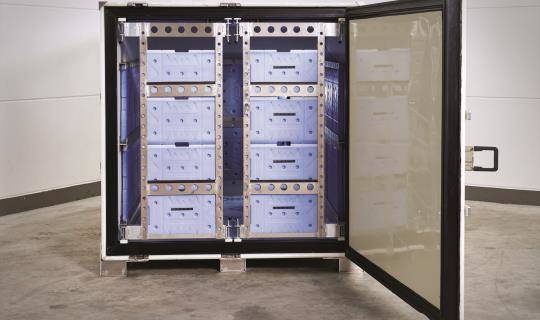Article: From Cold to Controlled
By World Courier
World Courier Ground Europe Reveals Impressive Test Results for New Fleet of Temperature-controlled Vehicles.
Qualification testing for the newest additions to the World Courier Ground Europe suite of vehicles has just been completed at Cambridge Refrigeration Technology (CRT) and the results are looking very impressive.
Our existing vehicles underwent type testing at the MIRA (Motor Industry Research Association) facility in 2011, but that test data could not be applied to the ten new vehicles, as we had incorporated important advances in temperature control technology in them. It was time to set up and run a new suite of Qualifications over an entire week, using two vehicles, involving a total of 170 hours in test.
The New Mercedes Benz Sprinters
The base chassis for the new vehicles continues to be built by Mercedes-Benz and, as with our previous van fleet, they have been built with the addition of a Hatcher Deep Sleeper1 cab. As our Ground business has evolved we have seen the journeys covered extend beyond core Europe into countries like Turkey, Morocco and Cyprus—with the drivers consequently away from home for extended periods. Providing them with a comfortable sleeping area is critical for their well-being and alertness, as guardians of the shipment, and also to maintain our excellent safety record.
The insulated body of our Mercedes-Benz Sprinter “Cube” vehicles is built by Solomons2, a leading manufacturer of temperature controlled vehicles in Europe and deliver excellent thermal properties and all vehicles are fitted with thermal curtains at the rear door to maintain temperature during the critical loading and unloading phases.
The latest vehicles have all been fitted with the latest Carrier3 Transicold evaporator and compressor unit, the all electric Pulsar unit—an upgrade from the previous belt-driven model. This new unit provides a more stable performance profile, regardless of whether the vehicle is moving or stationary at tickover. Precision in temperature control is also aided by the capability to set temperature to 0.1°C rather than one full degree.
Additional security has been fitted to the vehicles, which already carried alarms, tracking telemetry, deadlocks and a “key-out” system, so that the engine could continue operating whilst the driver stopped for fuel, a natural break, or on the open deck of a sea ferry crossing. Forward facing cameras are also fitted to all vehicles to monitor and manage operator behaviour.
The Testing
During our original test planning we elected to set ourselves a very high standard, which was to control the temperature within our vehicles based solely on the most volatile element—the air. With these new tests, we decided to augment that test programme by testing two Sprinter “Cube” units side-by-side. One unit again running completely empty, which would again set the absolute worst case for the vehicle to maintain temperature, and a second unit with a simulated half-capacity load of 3 full Europallets—each with thirty six boxes each containing 4 x 500 mL. of water, placed inside the load-lines identified in the MIRA testing from two years ago.
Pallets of the test substrate material were conditioned in a temperature controlled reefer positioned outside the CRT test facility, so that way it could be pre-conditioning for the next temperature requirement whilst the previous test was running. We added twenty-seven Sensitech temperature monitors inside each vehicle, together with a further eight thermocouples from CRT. No change in temperature was going to go unrecorded!
Gary Barnes Transport Manager was responsible for adding in all of the monitors and the onsite management of the testing process. He shared his experience with us. “Positioning all the monitors was a long job, but we’ve covered everywhere within the load-space. I’ve been looking forward to seeing if the changes we have made follow through to improvements in the performance.”
As a standard the Sprinter “Cube” fleet, every vehicle is fitted with three internal and one external temperature probes. The data from these monitors are uploaded every ten minutes by telemetry, together with the status, position and speed of the vehicle. This allows us to look at what is happening under ‘normal’ temperature conditions, whether we are in Norway in the winter or Italy in the summer. What it also allowed during the tests was for us to keep track of whether the performance was what we were expecting as we went along.
When creating the test protocol we decided to stress test at very high and very low temperatures which are at the limits of what we might expect to experience on the road. We set the high external temperature to +40°C, and the test chamber achieved between 38-40°C during the test. The lowest external was set at -25°C and the test chamber achieved between -22°C and -25°C.
We were also very clear that we needed to establish what temperatures were achieved within the loads-pace using either of the possible power sources; normal engine power and backup electrical power, (plugged into the mains—usually only used if there is an issue with the vehicle, or on very specific pre-arranged ferry crossings), and we then simulated “power out”, with all power turned off in order to establish how long the internal air temperature would be maintained within range.

The Results
We had extremely good and consistent results on the powered tests. The power-off tests showed us that at the worst case (high internal temperature, very cold external and vice versa) that we have around an hour after the power goes off before the air temperature inside the vehicle starts to move outside the range. Of course, this does not mean that the product will go out of range as quickly, as its thermal mass mitigates the effect for some additional time, but it does mean that we have the data to be able to make decisions about whether we need to drive to the closest World Courier office to get further assistance, or take a different course of action. We are covered with service contracts with Mercedes-Benz and Carrier to have engineers from their local facility with us within 90 minutes, wherever we travel in Europe, in case of any problems with the vehicle or the evaporator unit.
All the other tests were completely successful, showing that the specifications are working perfectly and helping us meet the demand for fully GDP-compliant temperature controlled transport across Europe. New drivers have been vetted and documented and are all completing their training ready for delivery of the final units and the individual testing for each vehicle to be completed. Alan Bryan Director of Special Services said “We are extremely pleased with the results of the testing, and look forward to adding the new Sprinter “Cube’s” into our existing fleet. The addition of these new will further improve our response times across Europe and, on the technical front, to meet client’s increasingly precise temperature-control requirements.”
Footnotes:
1 http://www.hatchercomp.co.uk/pdfs/Deep Sleeper - Mercedes.pdf
2 http://www.solomoncommercials.co.uk/
3 http://www.transicold.carrier.com



